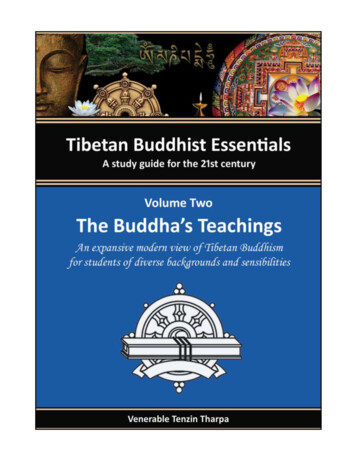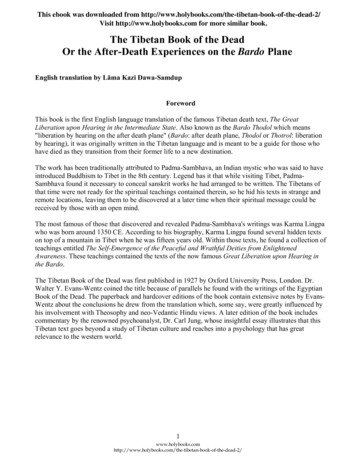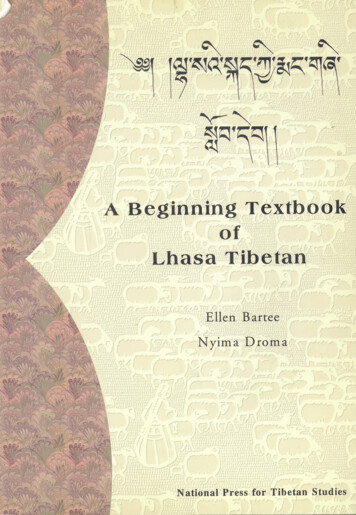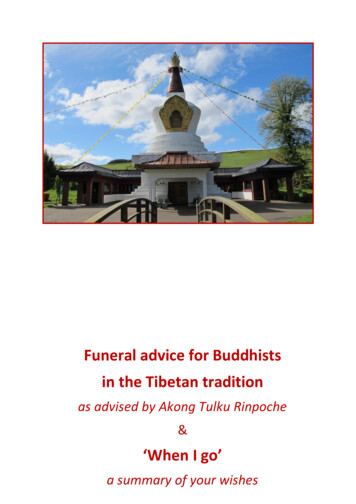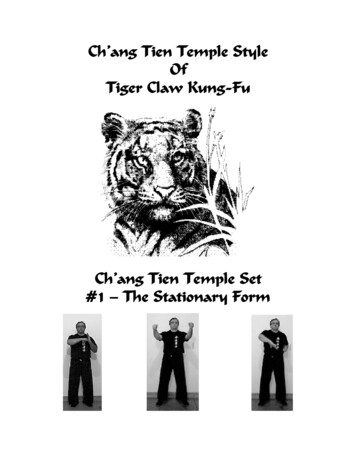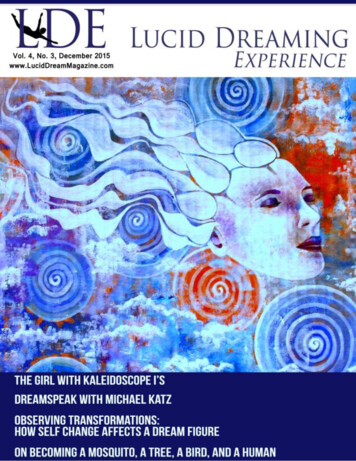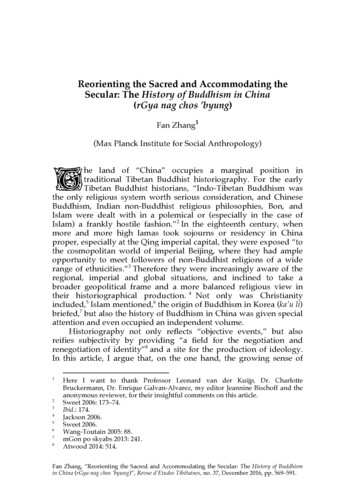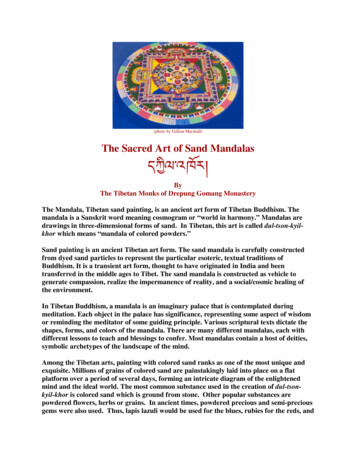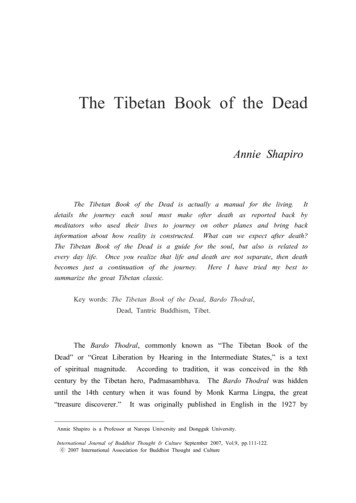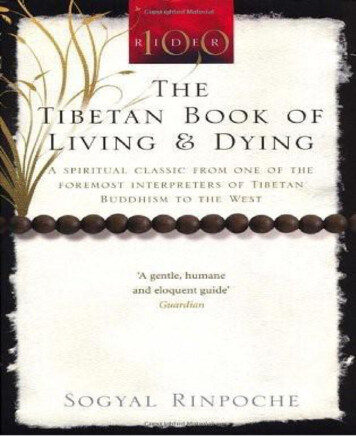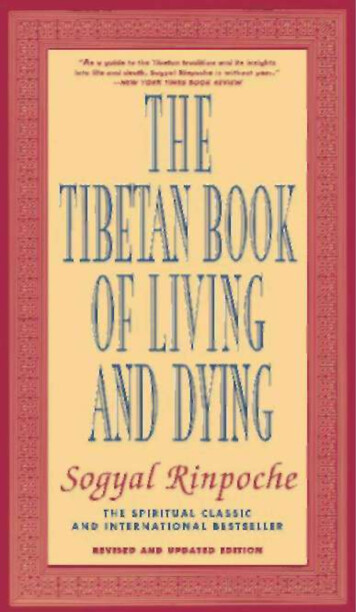
Transcription
The Tibetan Bookof Living and DyingSOGYAL RINPOCHERevised and UpdatedEdited byPATRICK GAFFNEY AND ANDREW HARVEY
I WOULD LIKE TO DEDICATE THIS BOOK TO Jamyang KhyentseChökyi Lodrö, Dudjom Rinpoche, Dilgo Khyentse Rinpoche, NyoshulKhen Rinpoche, Khyentse Sangyum Khandro TseringChödrön, and all my beloved masters, who have been the inspirationof my life.May this book be a guide to liberation, read by the living, and tothe dying, and for the dead.May it help all who read it and spur them on their journey toenlightenment!
ContentsDedicationForeword, by His Holiness the Dalai LamaIntroduction to the Revised Edition xiPreface xvixPART ONE: LIVING1.2.3.4.5.6.7.8.9.10.In the Mirror of Death 3Impermanence 15Reflection and Change 28The Nature of Mind 42Bringing the Mind Home 57Evolution, Karma, and Rebirth 86Bardos and Other Realities 106This Life: The Natural Bardo 115The Spiritual Path 131The Innermost Essence 154PART TWO: DYING11.12.13.14.15.Heart Advice on Helping the Dying 177Compassion: The Wish-Fulfilling Jewel 191Spiritual Help for the Dying 213The Practices for Dying 227The Process of Dying 248PART THREE: DEATH AND REBIRTH16.17.18.19.20.The Ground 263Intrinsic Radiance 278The Bardo of Becoming 291Helping After Death 303The Near-Death Experience: A Staircase toHeaven? 323vii
viiiCONTENTSPART FOUR: CONCLUSION21. The Universal Process 34322. Servants of Peace 360AppendixAppendixAppendixAppendix1: My Teachers 3712: Questions About Death3: Two Stories 3854: Two Mantras 393Notes 399Selected Bibliography 415Acknowledgments 419Index 425About the AuthorCreditsCoverCopyrightAbout the Publisher378
Forewordby His Holiness the Dalai LamaIN THIS TIMELY BOOK, Sogyal Rinpoche focuses onhow to understand the true meaning of life, how to acceptdeath, and how to help the dying, and the dead.Death is a natural part of life, which we will all surely haveto face sooner or later. To my mind, there are two ways wecan deal with it while we are alive. We can either choose toignore it or we can confront the prospect of our own deathand, by thinking clearly about it, try to minimize the sufferingthat it can bring. However, in neither of these ways can weactually overcome it.As a Buddhist, I view death as a normal process, a realitythat I accept will occur as long as I remain in this earthly existence. Knowing that I cannot escape it, I see no point in worrying about it. I tend to think of death as being like changingyour clothes when they are old and worn out, rather than assome final end. Yet death is unpredictable: We do not knowwhen or how it will take place. So it is only sensible to takecertain precautions before it actually happens.Naturally, most of us would like to die a peaceful death,but it is also clear that we cannot hope to die peacefully if ourlives have been full of violence, or if our minds have mostlybeen agitated by emotions like anger, attachment, or fear. So ifwe wish to die well, we must learn how to live well: Hopingfor a peaceful death, we must cultivate peace in our mind, andin our way of life.As you will read here, from the Buddhist point of view, theactual experience of death is very important. Although how orwhere we will be reborn is generally dependent on karmicforces, our state of mind at the time of death can influence thequality of our next rebirth. So at the moment of death, inspite of the great variety of karmas we have accumulated, ifwe make a special effort to generate a virtuous state of mind,we may strengthen and activate a virtuous karma, and sobring about a happy rebirth.ix
XFOREWORDThe actual point of death is also when the most profoundand beneficial inner experiences can come about Throughrepeated acquaintance with the processes of death in meditation, an accomplished meditator can use his or her actual deathto gain great spiritual realization. This is why experienced practitioners engage in meditative practices as they pass away Anindication of their attainment is that often their bodies do notbegin to decay until long after they are clinically dead.No less significant than preparing for our own death ishelping others to die well. As a newborn baby each of us washelpless and, without the care and kindness we received then,we would not have survived. Because the dying also areunable to help themselves, we should relieve them of discomfort and anxiety, and assist them, as far as we can, to die withcomposure.Here the most important point is to avoid anything whichwill cause the dying person's mind to become more disturbedthan it may already be. Our prime aim in helping a dying person is to put them at ease, and there are many ways of doingthis. A dying person who is familiar with spiritual practicemay be encouraged and inspired if they are reminded of it,but even kindly reassurance on our part can engender a peaceful, relaxed attitude in the dying person's mind.Death and Dying provide a meeting point between theTibetan Buddhist and modern scientific traditions. I believeboth have a great deal to contribute to each other on the levelof understanding and of practical benefit. Sogyal Rinpoche isespecially well placed to facilitate this meeting; having beenborn and brought up in the Tibetan tradition, he has receivedinstructions from some of our greatest Lamas. Having alsobenefitted from a moden education and lived and worked asa teacher for many years in the West, he has become wellacquainted with Western ways of thought.This book offers readers not just a theoretical account ofdeath and dying, but also practical measures for understanding,and for preparing themselves and others in a calm and fulfilling way.June 2, 1992The Dalai Lama
Introduction to the Revised EditionIT IS N O W TEN YEARS SINCE The Tibetan Book of Living and Dying was first published. In this book, I endeavoredto share something of the wisdom of the tradition I grew upin. I sought to show the practical nature of its ancient teachings, and the ways in which they can help us at every stage ofliving and dying. Many people, over the years, had urged meto write this book. They said that it would help relieve someof the intense suffering that so many of us go through in themodern world. As His Holiness the Dalai Lama has pointedout, we are living in a society in which people find it harderand harder to show one another basic affection, and whereany inner dimension to life is almost entirely overlooked. It isno wonder that there is today such a tremendous thirst for thecompassion and wisdom that spiritual teachings can offer.It must have been as a reflection of this need that TheTibetan Book of Living and Dying was received with such enthusiasm around the world. At first I was astonished: I had neverexpected it to have such an impact, especially since at thetime of writing this book, death was still very much a subjectthat was shunned and ignored. Gradually, as I traveled to different countries, teaching and leading workshops and trainingsbased on the teachings in this book, I discovered the extent towhich it had struck a chord in people's hearts. More and moreindividuals came up to me or wrote to tell me how theseteachings had helped them through a crisis in their lives orsupported them through the death of a loved one. And eventhough the teachings it contains may be unfamiliar, there arethose who have told me they have read this book severaltimes and keep returning to it as a source of inspiration. Afterreading The Tibetan Book of Living and Dying, a woman inMadras in India was so inspired that she founded a medicaltrust, with a hospice and palliative care center. Another personxt
xiiINTRODUCTIONin the United States came to me and said she was baffled byhow a mere book could have, in her words, "loved her socompletely." Stories like these, so moving and so personal, testify to the power and relevance of the Buddhist teachingstoday. Whenever I hear them, my heart fills with gratitude,both to the teachings themselves and to the teachers and practitioners who have undergone so much in order to embodythem and hand them on.In time, I came to learn that The Tibetan Book of Living andDying had been adopted by institutions, centers, and groups ofvarious kinds, educational, medical, and spiritual. Nurses, doctors, and those professionally involved with care for the dyinghave told me how they have integrated these methods in theirdaily work, and I have heard many accounts of ordinary peopleusing these practices and finding that they transformed thedeath of a friend or close relative. Something I find especiallymoving is that this book has been read by people with different spiritual beliefs, and they have said that it has strengthened and deepened their faith in their own tradition. Theyseem to recognize the universality of its message, and understand that it aims not to persuade or convert, but simply tooffer the wisdom of the ancient Buddhist teachings in order tobring the maximum possible benefit.As The Tibetan Book of Living and Dying quietly took on alife of its own, moving inconspicuously through manydomains and disciplines, I began to understand the ultimatesource of its great influence and appeal. These extraordinaryteachings are the heart essence of the oral lineage, that unbroken line of wisdom passed down as a living experience overthe centuries. Someone once called this book "midwaybetween a living master and a book," and it is true that bothin The Tibetan Book of Living and Dying and behind it, supporting it with their advice and answers to questions, are thegreatest masters of our time. It is their voice that speaksthrough these pages, their wisdom and their vision of a compassionate world infused by the knowledge of our true nature,the innermost nature of mind. The impact of The Tibetan Bookof Living and Dying, I believe, is due to the blessing of the lineage and the vibrancy of the oral tradition. Its popularity hasbeen a humbling experience for me, and it has reminded methat if I have any ability to communicate these teachings, it isonly because of the devotion inspired in me by the teachingsand the kindness of my masters, and nothing else.Over these last ten years there have been many changes in
INTRODUCTIONxiiiour attitudes toward death and in the kind of care we as asociety offer to the dying and the bereaved. Public awarenessof death and the many issues surrounding dying has beenheightened. Books, Web sites, conferences, serious radio andtelevision series, films, and support groups have all contributedto a greater openness toward looking into death. There hasbeen a considerable expansion in hospice work and palliativecare, and this has been the period during which, in somecountries, the whole field of care for the dying has beenopened up. Initiatives of many kinds have taken place,inspired by courageous men and women, for whom I havethe greatest respect and admiration. Meanwhile, there havebeen more and more requests for those working in the Buddhist tradition to take part in projects and explore how theycan contribute.A number of my friends and students have gradually created an international program of education and training basedon the teachings in this book and designed to offer spiritualcare to the dying, their families, and those who care for them.We offer courses for the medical profession and the public,coordinate volunteers, and have begun to work hand in handwith hospitals, clinics, hospices, and universities. What isencouraging is that there is a growing recognition everywherethat spiritual issues are central to the care of the dying, and insome countries a number of medical schools now offercourses in spirituality and medicine. Yet, I am told, surveysshow that denial of death still prevails, and we are still lackingin our ability to offer spiritual help and care for the dying andanswer their deepest needs. The kind of death we have is soimportant. Death is the most crucial moment of our lives, andeach and every one of us should be able to die in peace andfulfillment, knowing that we will be surrounded by the best inspiritual care.If The Tibetan Book of Living and Dying has played somesmall part in helping us look at how we deal with our owndeath and that of those around us, it is an answer to myprayers, and I am deeply moved and grateful. It is still mydream that the teachings presented here be made available topeople everywhere, of all ages, and at all levels of education.My original hope for this book was that it would help inspirea quiet revolution in the whole way we look at death andcare for the dying, and so the whole way we look at life andcare for the living. Our need for spiritual transformation and totake responsibility, in the truest sense, for ourselves and others
xivINTRODUCTIONhas not become any less urgent these ten years on. Whatwould it mean if more and more people thought seriouslyabout their future and the future of the world? Imagine howthings would be if we could live our lives infusing them witha sacred meaning; if our end-of-life care were always lit by asense of awe in the face of death; and if we looked on lifeand death themselves as an inseparable whole. What wouldbe the effect of seeking to make love and compassion themeasure of our every action, and of understanding, to anydegree, the inmost nature of the mind that underlies our entireexistence? This would be a true revolution, one that wouldfree men and women to discover their birthright, that innerdimension so long neglected, and unite them with the fullnessof the human experience in all its mystery and grandeur.Sogyal RinpocheLerab Ling, FranceNovember 2001
PrefaceI WAS BORN IN TIBET, and I was six monthsold when I entered the monastery of my master JamyangKhyentse Chökyi Lodrö, in the province of Kham. In Tibet wehave a unique tradition of finding the reincarnations of greatmasters who have passed away. They are chosen young andgiven a special education to train them to become the teachersof the future. I was given the name Sogyal, even though itwas only later that my master recognized me as the incarnation of Tertön Sogyal, a renowned mystic who was one of hisown teachers and a master of the Thirteenth Dalai Lama.My master, Jamyang Khyentse, was tall for a Tibetan, andhe always seemed to stand a good head above others in acrowd. He had silver hair, cut very short, and kind eyes thatglowed with humor. His ears were long, like those of the Buddha. But what you noticed most about him was his presence.His glance and bearing told you that he was a wise and holyman. He had a rich, deep, enchanting voice, and when hetaught his head would tilt slightly backward and the teachingwould flow from him in a stream of eloquence and poetry.And for all the respect and even awe he commanded, therewas humility in everything he did.Jamyang Khyentse is the ground of my life, and the inspiration of this book. He was the incarnation of a master whohad transformed the practice of Buddhism in our country. InTibet it was never enough simply to have the name of anincarnation, you always had to earn respect, through yourlearning and through your spiritual practice. My master spentyears in retreat, and many miraculous stories are told abouthim. He had profound knowledge and spiritual realization, andI came to discover that he was like an encyclopedia of wisdom, and knew the answer to any question you might askhim. There were many spiritual traditions in Tibet, butxv
xviPREFACEJamyang Khyentse was acclaimed as the authority on them all.He was, for everyone who knew or heard about him, theembodiment of Tibetan Buddhism, a living proof of howsomeone who had realized the teachings and completed theirpractice would be.I have heard that my master said that I would help continue his work, and certainly he always treated me like hisown son. I feel that what I have been able to achieve now inmy work, and the audience I have been able to reach, is aripening of the blessing he gave me.All my earliest memories are of him. He was the environment in which I grew up, and his influence dominated mychildhood. He was like a father to me. He would grant meanything I asked. His spiritual consort, Khandro TseringChödrön, who is also my aunt, used to say: "Don't disturbRinpoche, he might be busy,"1 but I would always want to bethere next to him, and he was happy to have me with him.I would pester him with questions all the time, and he alwaysanswered me patiently. I was a naughty child; none of mytutors were able to discipline me. Whenever they tried tobeat me, I would run to my master and climb up behindhim, where no one would dare to go. Crouching there,I felt proud and pleased with myself; he would just laugh.Then one day, without my knowledge, my tutor pleadedwith him, explaining that for my own benefit this could notgo on. The next time I fled to hide, my tutor came into theroom, did three prostrations to my master, and draggedme out. I remember thinking, as I was hauled out of theroom, how strange it was that he did not seem to be afraidof my master.Jamyang Khyentse used to live in the room where his previous incarnation had seen his visions and launched the renaissance of culture and spirituality that swept through easternTibet in the last century. It was a wonderful room, not particularly large but with a magical atmosphere, full of sacredobjects, paintings, and books. They called it "the heaven of thebuddhas," "the room of empowerment," and if there is oneplace that I remember in Tibet, it is that room. My master saton a low seat made of wood and strips of leather, and I satnext to him. I would refuse to eat if it was not from his bowl.In the small bedroom close by, there was a veranda, but itwas always quite dark, and there was always a kettle with teabubbling away on a little stove in the comer. Usually I slept
PREFACExviinext to my master, on a small bed at the foot of his own. Onesound I shall never forget is the clicking of the beads of hismala, his Buddhist rosary, as he whispered his prayers. When Iwent to sleep he would be there, sitting and practicing; andwhen I awoke in the morning he would already be awakeand sitting and practicing again, overflowing with blessing andpower. As I opened my eyes and saw him, I would be filledwith a warm and cozy happiness. He had such an air of peaceabout him.As I grew older, Jamyang Khyentse would make me presideover ceremonies, while he took the part of chant leader. I waswitness to all the teachings and initiations that he gave to others; but rather than the details, what I remember now is theatmosphere. For me he was the Buddha, of that there was noquestion in my mind. And everyone else recognized it as well.When he gave initiations, his disciples were so overawed theyhardly dared look into his face. Some would see him actuallyin the form of his predecessor, or as different buddhas andbodhisattvas.2 Everyone called him Rinpoche, "the Precious One,"which is the tide given to a master, and when he was presentno other teacher would be addressed in that way. His presence was so impressive that many affectionately called him"the Primordial Buddha."3Had I not met my master Jamyang Khyentse, I know Iwould have been an entirely different person. With hiswarmth and wisdom and compassion, he personified thesacred truth of the teachings and so made them practical andvibrant with life. Whenever I share that atmosphere of mymaster with others, they can sense the same profound feelingit aroused in me. What then did Jamyang Khyentse inspire inme? An unshakable confidence in the teachings, and a conviction in the central and dramatic importance of the master.Whatever understanding I have, I know I owe it to him. Thisis something I can never repay, but I can pass on to others.Throughout my youth in Tibet I saw the kind of loveJamyang Khyentse used to radiate in the community, especially in guiding the dying and the dead. A lama in Tibet wasnot only a spiritual teacher but also wise man, therapist, parishpriest, doctor, and spiritual healer, helping the sick and thedying. Later I was to learn the specific techniques for guidingthe dying and the dead from the teachings connected with theTibetan Book of the Dead. But the greatest lessons I ever learnedabout death—and life—came from watching my master as he
xviiiPREFACEguided dying people with infinite compassion, wisdom, andunderstanding.I pray this book will transmit something of his great wisdom and compassion to the world, and, through it, you too,wherever you are, can come into the presence of his wisdommind and find a living connection with him.
PART ONELiving
ONEIn the Mirror of DeathMY OWN FIRST EXPERIENCE of death came when Iwas about seven. We were preparing to leave the easternhighlands to travel to central Tibet. Samten, one of the personal attendants of my master, was a wonderful monk whowas kind to me during my childhood. He had a bright, round,chubby face, always ready to break into a smile. He waseveryone's favorite in the monastery because he was so goodnatured. Every day my master would give teachings and initiations and lead practices and rituals. Toward the end of theday, I would gather together my friends and act out a littletheatrical performance, reenacting the morning's events. It wasSamten who would always lend me the costumes my masterhad worn in the morning. He never refused me.Then suddenly Samten fell ill, and it was clear he was notgoing to live. We had to postpone our departure. I will neverforget the two weeks that followed. The rank smell of deathhung like a cloud over everything, and whenever I think ofthat time, that smell comes back to me. The monastery wassaturated with an intense awareness of death. This was not atall morbid or frightening, however; in the presence of mymaster, Samten's death took on a special significance. Itbecame a teaching for us all.Samten lay on a bed by the window in a small temple inmy master's residence. I knew he was dying. From time to timeI would go in and sit by him. He could not talk, and I wasshocked by the change in his face, which was now so haggardand drawn. I realized that he was going to leave us and wewould never see him again. I felt intensely sad and lonely.Samten's death was not an easy one. The sound of hislabored breathing followed us everywhere, and we could smellhis body decaying. The monastery was overwhelmingly silentexcept for this breathing. Everything focused on Samten. Yet3
4THE TIBETAN BOOK OF LIVING AND DYINGalthough there was so much suffering in Samten's prolongeddying, we could all see that deep down he had a peace andinner confidence about him. At first I could not explain this,but then I realized what it came from: his faith and his training, and the presence of our master. And though I felt sad, Iknew then that if our master was there, everything wouldturn out all right, because he would be able to help Samtentoward liberation. Later I came to know that it is the dream ofany practitioner to die before his master and have the goodfortune to be guided by him through death.As Jamyang Khyentse guided Samten calmly through hisdying, he introduced him to all the stages of the process hewas going through, one by one. I was astonished by the precision of my master's knowledge, and by his confidence andpeace. When my master was there, his peaceful confidencewould reassure even the most anxious person. Now JamyangKhyentse was revealing to us his fearlessness of death. Notthat he ever treated death lightly: He often told us that he wasafraid of it, and warned us against taking it naively or complacently. Yet what was it that allowed my master to face deathin a way that was at once so sober and so lighthearted, sopractical yet so mysteriously carefree? That question fascinatedand absorbed me.Samten's death shook me. At the age of seven, I had myfirst glimpse of the vast power of the tradition I was beingmade part of, and I began to understand the purpose of spiritual practice. Practice had given Samten an acceptance ofdeath, as well as a clear understanding that suffering and paincan be part of a deep, natural process of purification. Practicehad given my master a complete knowledge of what death is,and a precise technology for guiding individuals through it.After Samten died we set off for Lhasa, the capital of Tibet, atortuous three-month journey on horseback. From there wecontinued our pilgrimage to the sacred sites of central andsouthern Tibet. These are the holy places of the saints, kings,and scholars who brought Buddhism to Tibet from the seventh century onward. My master was the emanation of manymasters of all traditions, and because of his reputation he wasgiven a tumultuous reception everywhere we went.For me that journey was extremely exciting, and hasremained full of beautiful memories. Tibetans rise early, inorder to make use of all the natural light. We would go to bed
IN THE MIRROR OF DEATH5at dusk and rise before daybreak, and by first light the yakscarrying the baggage would be moving out. The tents wouldbe struck, and the last ones to come down were the kitchenand my master's tent. A scout would go ahead to choose agood camping place, and we would stop and camp aroundnoon for the rest of the day. I used to love to camp by a riverand listen to the sound of the water, or to sit in the tent andhear the rain pattering on the roof.We were a small party with about thirty tents in all. Duringthe day I rode on a golden-colored horse next to my master.While we rode he gave teachings, told stories, practiced, andcomposed a number of practices specially for me. One day, aswe drew near the sacred lake of Yamdrok Tso, and caughtsight of the turquoise radiance of its waters, another Lama inour party, Lama Tseten, began to die.The death of Lama Tseten proved another strong teachingfor me. He was the tutor to my master's spiritual wife,Khandro Tsering Chödrön, who is still alive today. She isregarded by many as Tibet's foremost woman practitioner, ahidden master who for me is an embodiment of devotion,teaching through the simplicity of her loving presence. LamaTseten was an immensely human and grandfatherly character.He was over sixty, quite tall and with gray hair, and exudedan effortless gentleness. He was also a highly accomplishedpractitioner of meditation, and just to be near him used togive me a sense of peace and serenity. Sometimes he wouldscold me, and I would be afraid of him; but for all his occasional sternness, he never lost his warmth.Lama Tseten died in an extraordinary way. Although therewas a monastery close by, he refused to go there, saying hedid not want to leave a corpse for them to clear up. So wecamped and pitched our tents in a circle as usual. Khandrowas nursing and caring for Lama Tseten, as he was her tutor.She and I were the only two people in his tent when he suddenly called her over. He had an endearing way of calling her"A-mi," meaning "my child" in his local dialect. "A-mi," hesaid tenderly, "come here. It's happening now. I've no furtheradvice for you. You are fine as you are: I am happy with you.Serve your master just as you have been doing."Immediately she turned to run out of the tent, but hecaught her by the sleeve. "Where are you going?" he asked."I'm going to call Rinpoche," she replied."Don't bother him, there's no need," he smiled. "With themaster, there's no such thing as distance." With that, he just
6THE TIBETAN BOOK OF LIVING AND DYINGgazed up into the sky and passed away. Khandro released herself from his grip and rushed out to call my master. I sat there,unable to move.I was amazed that anyone who was staring into the face ofdeath could have that kind of confidence. Lama Tseten couldhave had his Lama there in person to help him—somethinganyone else would have longed for—but he had no need. Iunderstand why now: He had already realized the presence ofthe master within himself. Jamyang Khyentse was there withhim always, in his mind and heart; never for one moment didhe feel any separation.Khandro did go to fetch Jamyang Khyentse.1 I shall neverforget how he stooped to enter the tent. He gave one look atLama Tseten's face, and then, peering into his eyes, began tochuckle. He always used to call him "La Gen," "old Lama"; itwas a sign of his affection. "La Gen," he said, "don't stay inthat state!" He could see, I now understand, that Lama Tsetenwas doing one particular practice of meditation in which thepractitioner merges the nature of his mind with the space oftruth and can remain in that state for many days as he dies."La Gen, we are travelers. We're pilgrims. We don't have thetime to wait that long. Come on. I'll guide you."Transfixed, I watched what happened next, and if I hadn'tseen it myself I would never have believed it. Lama Tsetencame back to life. Then my master sat by his side and took himthrough the phowa, the practice for guiding the consciousnessat the moment before death. There are many ways of doingthis practice, and the one he used then culminated with themaster uttering the syllable "A" three times. As my masterdeclared the first "A," we could hear Lama Tseten accompanying him quite audibly. The second time his voice was less distinct, and the third time it was silent; he had gone.The death of Samten taught me the purpose of spiritualpractice; Lama Tseten's death taught me that it is not unusualfor practitioners of his caliber to conceal their remarkable qualities during their lifetime. Sometimes, in fact, they show themonly once, at the moment of death. I understood, even as achild, that there was a striking difference between the death ofSamten and that of Lama Tseten, and I realized that it was thedifference between the death of a good monk who had practiced in his life and that of a much more realized practitioner.Samten died in an ordinary way and in pain, yet with theconfidence of faith; Lama Tseten's death was a display of spiritual mastery.
IN THE MIRROR
11. Heart Advice on Helping the Dying 177 12. Compassion: The Wish-Fulfilling Jewel 191 13. Spiritual Help for the Dying 213 14. The Practices for Dying 227 15. The Process of Dying 248 PART THREE: DEATH AND REBIRTH 16. The Ground 263 17. Intrinsic Radiance 278 18.
